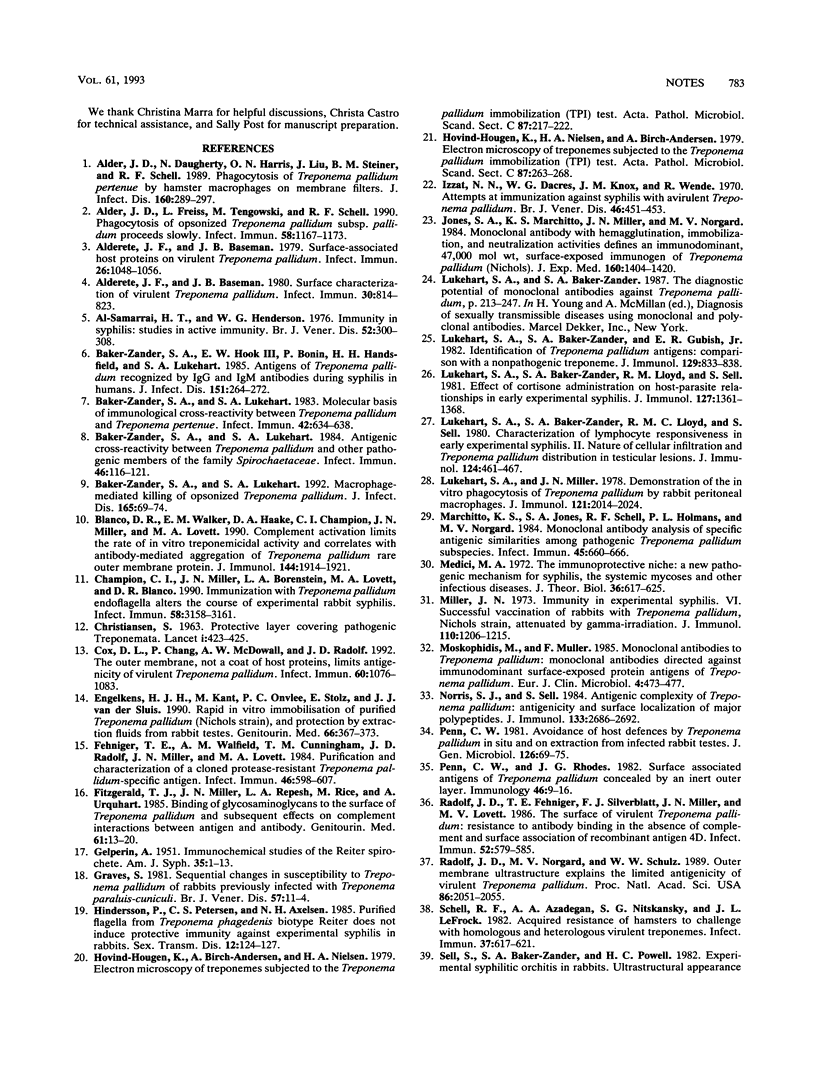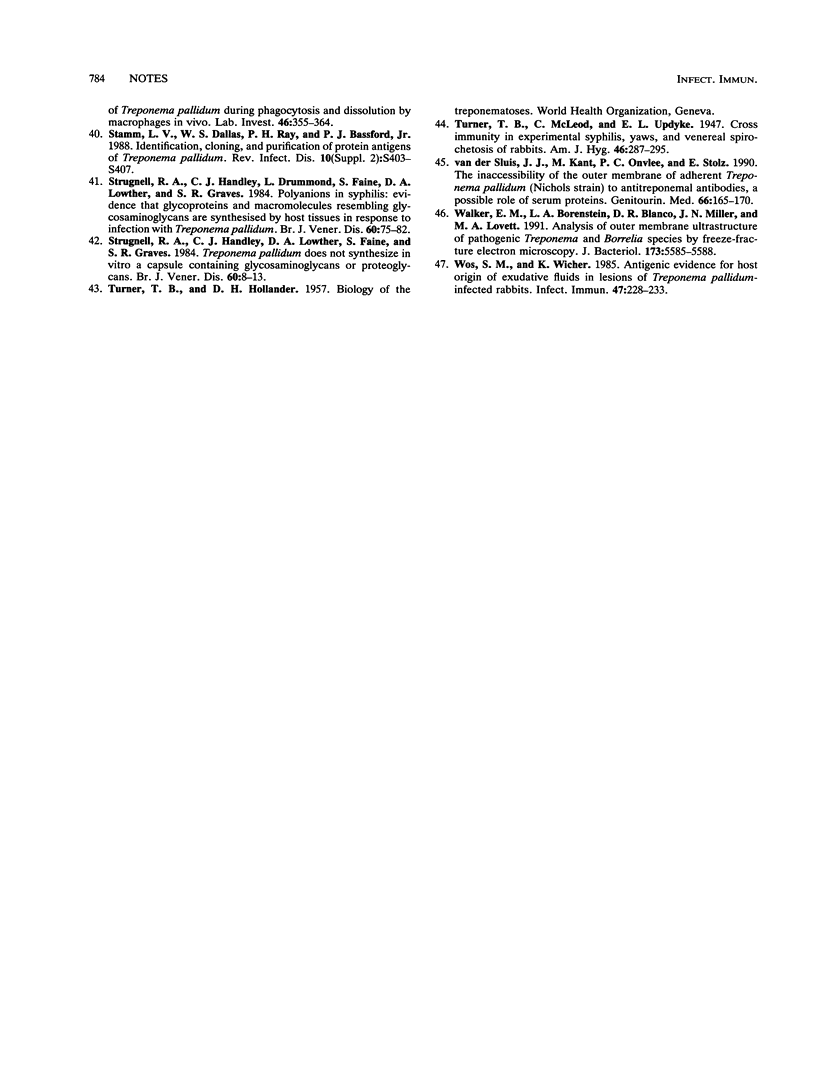Abstract
Rabbit antisera to Leptospira interrogans, Borrelia hermsii, and Treponema phagedenis biotype Reiter, reactive to shared spirochetal antigens, failed to enhance phagocytosis of Treponema pallidum by macrophages, while immunoglobulin G to Treponema pallidum subsp. pertenue and Treponema paraluiscuniculi promoted phagocytosis. Opsonic antibodies are directed to pathogen-restricted, not shared spirochetal, antigens.
Full text
PDF



Selected References
These references are in PubMed. This may not be the complete list of references from this article.
- Al-Samarrai H. T., Henderson W. G. Immunity in syphilis. Studies in active immunity. Br J Vener Dis. 1976 Oct;52(5):300–308. doi: 10.1136/sti.52.5.300. [DOI] [PMC free article] [PubMed] [Google Scholar]
- Alder J. D., Daugherty N., Harris O. N., Liu H., Steiner B. M., Schell R. F. Phagocytosis of Treponema pallidum pertenue by hamster macrophages on membrane filters. J Infect Dis. 1989 Aug;160(2):289–297. doi: 10.1093/infdis/160.2.289. [DOI] [PubMed] [Google Scholar]
- Alder J. D., Friess L., Tengowski M., Schell R. F. Phagocytosis of opsonized Treponema pallidum subsp. pallidum proceeds slowly. Infect Immun. 1990 May;58(5):1167–1173. doi: 10.1128/iai.58.5.1167-1173.1990. [DOI] [PMC free article] [PubMed] [Google Scholar]
- Alderete J. F., Baseman J. B. Surface characterization of virulent Treponema pallidum. Infect Immun. 1980 Dec;30(3):814–823. doi: 10.1128/iai.30.3.814-823.1980. [DOI] [PMC free article] [PubMed] [Google Scholar]
- Alderete J. F., Baseman J. B. Surface-associated host proteins on virulent Treponema pallidum. Infect Immun. 1979 Dec;26(3):1048–1056. doi: 10.1128/iai.26.3.1048-1056.1979. [DOI] [PMC free article] [PubMed] [Google Scholar]
- Baker-Zander S. A., Hook E. W., 3rd, Bonin P., Handsfield H. H., Lukehart S. A. Antigens of Treponema pallidum recognized by IgG and IgM antibodies during syphilis in humans. J Infect Dis. 1985 Feb;151(2):264–272. doi: 10.1093/infdis/151.2.264. [DOI] [PubMed] [Google Scholar]
- Baker-Zander S. A., Lukehart S. A. Antigenic cross-reactivity between Treponema pallidum and other pathogenic members of the family Spirochaetaceae. Infect Immun. 1984 Oct;46(1):116–121. doi: 10.1128/iai.46.1.116-121.1984. [DOI] [PMC free article] [PubMed] [Google Scholar]
- Baker-Zander S. A., Lukehart S. A. Macrophage-mediated killing of opsonized Treponema pallidum. J Infect Dis. 1992 Jan;165(1):69–74. doi: 10.1093/infdis/165.1.69. [DOI] [PubMed] [Google Scholar]
- Baker-Zander S. A., Lukehart S. A. Molecular basis of immunological cross-reactivity between Treponema pallidum and Treponema pertenue. Infect Immun. 1983 Nov;42(2):634–638. doi: 10.1128/iai.42.2.634-638.1983. [DOI] [PMC free article] [PubMed] [Google Scholar]
- Blanco D. R., Walker E. M., Haake D. A., Champion C. I., Miller J. N., Lovett M. A. Complement activation limits the rate of in vitro treponemicidal activity and correlates with antibody-mediated aggregation of Treponema pallidum rare outer membrane protein. J Immunol. 1990 Mar 1;144(5):1914–1921. [PubMed] [Google Scholar]
- CHRISTIANSEN S. Protective layer covering pathogenic treponemata. Lancet. 1963 Feb 23;1(7278):423–425. doi: 10.1016/s0140-6736(63)92309-2. [DOI] [PubMed] [Google Scholar]
- Champion C. I., Miller J. N., Borenstein L. A., Lovett M. A., Blanco D. R. Immunization with Treponema pallidum endoflagella alters the course of experimental rabbit syphilis. Infect Immun. 1990 Sep;58(9):3158–3161. doi: 10.1128/iai.58.9.3158-3161.1990. [DOI] [PMC free article] [PubMed] [Google Scholar]
- Cox D. L., Chang P., McDowall A. W., Radolf J. D. The outer membrane, not a coat of host proteins, limits antigenicity of virulent Treponema pallidum. Infect Immun. 1992 Mar;60(3):1076–1083. doi: 10.1128/iai.60.3.1076-1083.1992. [DOI] [PMC free article] [PubMed] [Google Scholar]
- Engelkens H. J., Kant M., Onvlee P. C., Stolz E., van der Sluis J. J. Rapid in vitro immobilisation of purified Treponema pallidum (Nichols strain), and protection by extraction fluids from rabbit testes. Genitourin Med. 1990 Oct;66(5):367–373. doi: 10.1136/sti.66.5.367. [DOI] [PMC free article] [PubMed] [Google Scholar]
- Fehniger T. E., Walfield A. M., Cunningham T. M., Radolf J. D., Miller J. N., Lovett M. A. Purification and characterization of a cloned protease-resistant Treponema pallidum-specific antigen. Infect Immun. 1984 Nov;46(2):598–607. doi: 10.1128/iai.46.2.598-607.1984. [DOI] [PMC free article] [PubMed] [Google Scholar]
- Fitzgerald T. J., Miller J. N., Repesh L. A., Rice M., Urquhart A. Binding of glycosaminoglycans to the surface of Treponema pallidum and subsequent effects on complement interactions between antigen and antibody. Genitourin Med. 1985 Feb;61(1):13–20. doi: 10.1136/sti.61.1.13. [DOI] [PMC free article] [PubMed] [Google Scholar]
- Graves S. Sequential changes in susceptibility to Treponema pallidum of rabbits previously infected with Treponema paraluis-cuniculi. Br J Vener Dis. 1981 Feb;57(1):11–14. doi: 10.1136/sti.57.1.11. [DOI] [PMC free article] [PubMed] [Google Scholar]
- Hindersson P., Petersen C. S., Axelsen N. H. Purified flagella from Treponema phagedenis biotype Reiter does not induce protective immunity against experimental syphilis in rabbits. Sex Transm Dis. 1985 Jul-Sep;12(3):124–127. doi: 10.1097/00007435-198507000-00006. [DOI] [PubMed] [Google Scholar]
- Hovind-Hougen K., Birch-Andersen A., Nielsen H. A. Electron microscopy of treponemes subjected to the Treponema pallidum immobilization (TPI) test. II. Immunoelectron microscopy. Acta Pathol Microbiol Scand C. 1979 Aug;87C(4):263–268. [PubMed] [Google Scholar]
- Hovind-Hougen K., Nielsen H. A., Birch-Andersen A. Electron microscopy of treponemes subjected to the Treponema pallidum immobilization (TPI) test. I. Comparison of immunoimmobilized cells and control cells. Acta Pathol Microbiol Scand C. 1979 Jun;87C(3):217–222. [PubMed] [Google Scholar]
- Izzat N. N., Dacres W. G., Knox J. M., Wende R. Attempts at immunization against syphilis with avirulent Treponemma pallidum. Br J Vener Dis. 1970 Dec;46(6):451–453. doi: 10.1136/sti.46.6.451. [DOI] [PMC free article] [PubMed] [Google Scholar]
- Jones S. A., Marchitto K. S., Miller J. N., Norgard M. V. Monoclonal antibody with hemagglutination, immobilization, and neutralization activities defines an immunodominant, 47,000 mol wt, surface-exposed immunogen of Treponema pallidum (Nichols). J Exp Med. 1984 Nov 1;160(5):1404–1420. doi: 10.1084/jem.160.5.1404. [DOI] [PMC free article] [PubMed] [Google Scholar]
- Lukehart S. A., Baker-Zander S. A., Gubish E. R., Jr Identification of Treponema pallidum antigens: comparison with a nonpathogenic treponeme. J Immunol. 1982 Aug;129(2):833–838. [PubMed] [Google Scholar]
- Lukehart S. A., Baker-Zander S. A., Lloyd R. M., Sell S. Characterization of lymphocyte responsiveness in early experimental syphilis. II. Nature of cellular infiltration and Treponema pallidum distribution in testicular lesions. J Immunol. 1980 Jan;124(1):461–467. [PubMed] [Google Scholar]
- Lukehart S. A., Baker-Zander S. A., Lloyd R. M., Sell S. Effect of cortisone administration on host-parasite relationships in early experimental syphilis. J Immunol. 1981 Oct;127(4):1361–1368. [PubMed] [Google Scholar]
- Lukehart S. A., Miller J. N. Demonstration of the in vitro phagocytosis of Treponema pallidum by rabbit peritoneal macrophages. J Immunol. 1978 Nov;121(5):2014–2024. [PubMed] [Google Scholar]
- Marchitto K. S., Jones S. A., Schell R. F., Holmans P. L., Norgard M. V. Monoclonal antibody analysis of specific antigenic similarities among pathogenic Treponema pallidum subspecies. Infect Immun. 1984 Sep;45(3):660–666. doi: 10.1128/iai.45.3.660-666.1984. [DOI] [PMC free article] [PubMed] [Google Scholar]
- Medici M. A. The immunoprotective niche--a new pathogenic mechanism for syphilis, the systemic mycoses and other infectious diseases. J Theor Biol. 1972 Sep;36(3):617–625. doi: 10.1016/0022-5193(72)90012-4. [DOI] [PubMed] [Google Scholar]
- Miller J. N. Immunity in experimental syphilis. VI. Successful vaccination of rabbits with Treponema pallidum, Nichols strain, attenuated by -irradiation. J Immunol. 1973 May;110(5):1206–1215. [PubMed] [Google Scholar]
- Moskophidis M., Müller F. Monoclonal antibodies to immunodominant surface-exposed protein antigens of Treponema pallidum. Eur J Clin Microbiol. 1985 Oct;4(5):473–477. doi: 10.1007/BF02014427. [DOI] [PubMed] [Google Scholar]
- Norris S. J., Sell S. Antigenic complexity of Treponema pallidum: antigenicity and surface localization of major polypeptides. J Immunol. 1984 Nov;133(5):2686–2692. [PubMed] [Google Scholar]
- Penn C. W. Avoidance of host defences by Treponema pallidum in situ and on extraction from infected rabbit testes. J Gen Microbiol. 1981 Sep;126(1):69–75. doi: 10.1099/00221287-126-1-69. [DOI] [PubMed] [Google Scholar]
- Penn C. W., Rhodes J. G. Surface-associated antigens of Treponema pallidum concealed by an inert outer layer. Immunology. 1982 May;46(1):9–16. [PMC free article] [PubMed] [Google Scholar]
- Radolf J. D., Fehniger T. E., Silverblatt F. J., Miller J. N., Lovett M. A. The surface of virulent Treponema pallidum: resistance to antibody binding in the absence of complement and surface association of recombinant antigen 4D. Infect Immun. 1986 May;52(2):579–585. doi: 10.1128/iai.52.2.579-585.1986. [DOI] [PMC free article] [PubMed] [Google Scholar]
- Radolf J. D., Norgard M. V., Schulz W. W. Outer membrane ultrastructure explains the limited antigenicity of virulent Treponema pallidum. Proc Natl Acad Sci U S A. 1989 Mar;86(6):2051–2055. doi: 10.1073/pnas.86.6.2051. [DOI] [PMC free article] [PubMed] [Google Scholar]
- Schell R. F., Azadegan A. A., Nitskansky S. G., LeFrock J. L. Acquired resistance of hamsters to challenge with homologous and heterologous virulent treponemes. Infect Immun. 1982 Aug;37(2):617–621. doi: 10.1128/iai.37.2.617-621.1982. [DOI] [PMC free article] [PubMed] [Google Scholar]
- Stamm L. V., Dallas W. S., Ray P. H., Bassford P. J., Jr Identification, cloning, and purification of protein antigens of Treponema pallidum. Rev Infect Dis. 1988 Jul-Aug;10 (Suppl 2):S403–S407. doi: 10.1093/cid/10.supplement_2.s403. [DOI] [PubMed] [Google Scholar]
- Strugnell R. A., Handley C. J., Drummond L., Faine S., Lowther D. A., Graves S. R. Polyanions in syphilis: evidence that glycoproteins and macromolecules resembling glycosaminoglycans are synthesised by host tissues in response to infection with Treponema pallidum. Br J Vener Dis. 1984 Apr;60(2):75–82. doi: 10.1136/sti.60.2.75. [DOI] [PMC free article] [PubMed] [Google Scholar]
- Strugnell R. A., Handley C. J., Lowther D. A., Faine S., Graves S. R. Treponema pallidum does not synthesise in vitro a capsule containing glycosaminoglycans or proteoglycans. Br J Vener Dis. 1984 Feb;60(1):8–13. doi: 10.1136/sti.60.1.8. [DOI] [PMC free article] [PubMed] [Google Scholar]
- Walker E. M., Borenstein L. A., Blanco D. R., Miller J. N., Lovett M. A. Analysis of outer membrane ultrastructure of pathogenic Treponema and Borrelia species by freeze-fracture electron microscopy. J Bacteriol. 1991 Sep;173(17):5585–5588. doi: 10.1128/jb.173.17.5585-5588.1991. [DOI] [PMC free article] [PubMed] [Google Scholar]
- Wos S. M., Wicher K. Antigenic evidence for host origin of exudative fluids in lesions of Treponema pallidum-infected rabbits. Infect Immun. 1985 Jan;47(1):228–233. doi: 10.1128/iai.47.1.228-233.1985. [DOI] [PMC free article] [PubMed] [Google Scholar]
- van der Sluis J. J., Kant M., Onvlee P. C., Stolz E. The inaccessibility of the outer membrane of adherent Treponema pallidum (Nichols strain) to anti-treponemal antibodies, a possible role of serum proteins. Genitourin Med. 1990 Jun;66(3):165–170. doi: 10.1136/sti.66.3.165. [DOI] [PMC free article] [PubMed] [Google Scholar]


